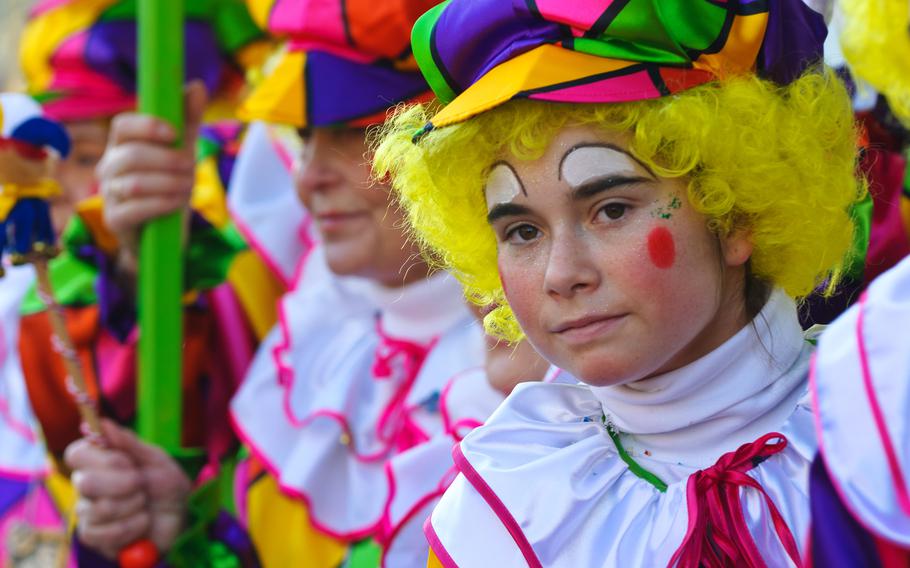
Carnival revelers, such as this parade participant in Wiesbaden, will take to the streets and sidewalks throughout Germany in coming days. (iStock)
Throughout much of Germany, the time of year most closely associated with festive parades is the climax of Carnival, and throughout the weekend and into Tuesday, there will be dozens of them to choose from. Following two years of COVID-19-related cancellations, revelers are anticipated to return to the streets in full force. Once again, they’ll be slapping on face paint and donning their craziest costumes to cheer on the musicians, marchers and fabulous floats they’ve missed so much. Children will be hoping for front-row spots, a definite advantage when scrambling to grab hold of the candies and trinkets tossed their way.
While those put off by crowds may wish to steer well clear of carnival festivities, particularly those typically seen in the three carnival stronghold cities of Cologne, Dusseldorf and Mainz, others may wish to brave the crush of humanity. Parades are generally free to watch, although at some of them, the purchase of a pin or souvenir helps the carnival organizers defray costs. Tribune seating is reserved for ticket-holders. Here are the dates and start times of various parades slated to take place near U.S. military communities.
Parades on Sunday, Feb. 19
Aschaffenburg: The Carnival parade in Aschaffenburg starts at 2 p.m. and continues for approximately two hours. The procession is somewhat influenced by the traditions of Mainz, whose archbishops and electors held power in the city for more than 700 years.
Frankfurt: Frankfurt’s parade gets underway at 12:21 p.m. From its start point at Untermainkai near the Main River, it makes its way past the beautiful square of gabled houses known as the Römerberg, where tribunes for guests with tickets have been set up.
Nuremberg: The “Fastnachtszug” gets going at 1 p.m. The starting point is the City Park on Bayreuther Strasse, from where it follows the route Rathenauplatz - Laufer Tor – Schlagturm - Laufer Gasse – Theresienplatz – Theresienstrasse – Fünferplatz – Obstmarkt – Spitalgasse – Museumsbrücke – Königstrasse – Kaiserstrasse – Josephsplatz - Vordere Ledergasse and ends at Saturn.
Wiesbaden: The city’s traditional parade starts at 12:11 p.m. from Friedrich-Ebert-Allee and makes its way down Wilhelmstrasse and through the city center to Bleichstrasse before entering onto the Ring Road and making its way back to its starting point.
Würzburg: The largest Carnival procession in Bavaria starts at 11:55 a.m. from Semmelstrasse in the Hauger district of the old town, from which it makes its way along Textorstrasse - Haugerpfarrgasse - Obere Juliuspromenade - Dominikanerplatz - Schönbornstrasse - Kürschnerhof - Domstrasse - Augustinerstrasse - Sanderstrasse - Sanderring. Some 120 groups with around 3,500 marchers will take part in a parade that typically attracts 80,000 or more spectators.
Parades on Rose Monday, Feb. 20
Aachen: The parade gets going at 11:11 a.m. from Adalbertsteinweg, from which it weaves its way along Wilhelmstrasse – Theaterstraße – Elisenbrunnen – Peterstrasse – Komphausbadstrasse – Seilgraben – Minoritenstrasse – Großkölnstraße – Markt – Jakobstrasse – Karlsgraben and ends at Templergraben. Some 220,000 spectators turned out for the 2020 edition of the parade.
Cologne: This Carnival celebrates its 200th anniversary this year, and the parade will cross over the Rhine River for the first time. Germany’s largest Carnival procession gets underway at 10 a.m. from the Deutz train station and makes its way toward the Old Town, past the cathedral, over the Ring road down Severinstrasse toward Chlodwigplatz. It would take about 3.5 hours to view the parade from start to finish. Once the parade has finished, the Alter Markt becomes party central.
Düsseldorf: A massive parade made up of 85 groups on foot, 30 brass bands and 110 floats begins at noon. The parade, Germany’s second-longest, stretches for nearly two miles and takes about three hours to view in full. Some of the major streets it passes along include Berliner Allee – Bahnstrasse - Königsallee - Burgplatz - Marktplatz - Bilker Strasse.
Mainz: The nearly four-mile-long parade made up of floats, brass bands, costumed flag-wavers and the “Schwellköppen” figures with their massive heads marches forward at 11:11 a.m. From 4:11 p.m., street parties take place on Ludwigsstraße and at Schillerplatz.
Saarbrücken-Burbach: The parade begins at 1:11 p.m. from the Bürgerhaus Rockershausen and passes along Luisenthalerstrasse and Bergstrasse before ending at Burbacher Stern. Up to 200,000 spectators have turned out in previous years.
Parades on Tuesday, Feb. 21
Karlsruhe: The parade sets off at 2:11 p.m. and ends with the symbolic burning of Carnival in front of the Town Hall.
Stuttgart: A parade takes place in the inner city from 2 p.m.-5 p.m., followed by a party at Karlsplatz.
Zweibrücken: The Carnival parade gets rolling at 2:11 p.m., following a route along Saarlandstrasse - Landauer Strasse - Alte Ixheimer Strasse – Lützelstrasse - Fruchtmarktstrasse and the ZOB station.